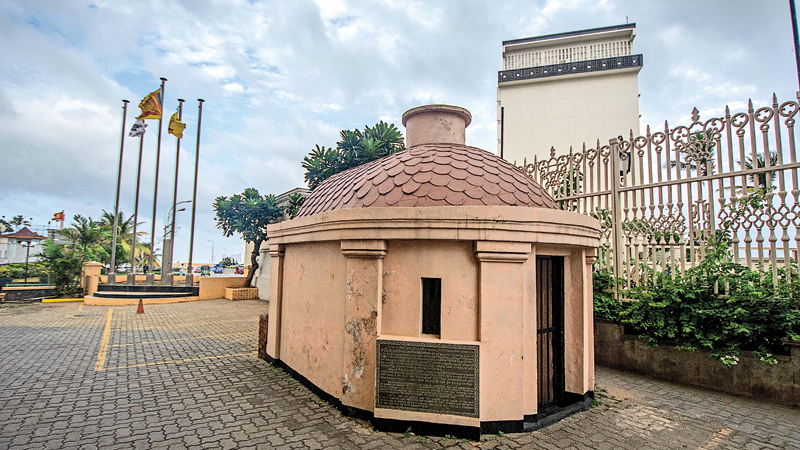 I have been eyeing a small cell in the car park of the Ceylinco Building at Echelon Square, bordering the Colombo Fort’s Clock Tower whenever I frequented this locality in Colombo. I used to stop a few seconds here and glance at this cell each time I visited it. Eventually, I had the idea of writing about this historic monument which denotes a sorrowful chapter in our history.
I have been eyeing a small cell in the car park of the Ceylinco Building at Echelon Square, bordering the Colombo Fort’s Clock Tower whenever I frequented this locality in Colombo. I used to stop a few seconds here and glance at this cell each time I visited it. Eventually, I had the idea of writing about this historic monument which denotes a sorrowful chapter in our history.
In what is now a small concrete structure in the parking lot of the Ceylinco Building in downtown Colombo Fort, the last King of Kandy saw his reign meet an ignominious end. Many people believe Sri Wickrama Rajasingha was imprisoned in this tiny, one-room cell with a capsule-shaped concrete roof, signalling the end of the Kandyan Kingdom and the beginning of the British rule. It is surrounded by many colonial architectural buildings in the Fort, such as, Queen’s House (President’s House), Cargills Building, Dutch Hospital and the famous Fort Clock Tower.
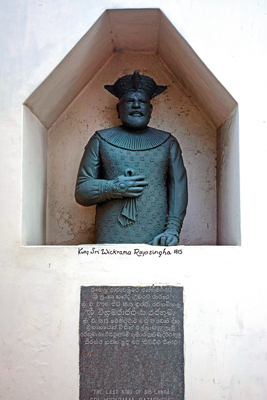
The bust of King Sri Wickrama Rajasingha adorns the rear side of the cell
Just as I peeped into this tiny cell, I wondered whether the last King of the country had been imprisoned in this cell. According to historical notes, the King had been brought down to the Colombo Fort from Kandy and it is said that the British had given due respect for the King and kept him in a spacious house. Due to his unruly behaviour, he was imprisoned in this cell and later deported to Vellore in India.
Archaeological monument
The prison cell in the car park of the Ceylinco Building, is an archaeological monument preserved by the Department of Archaeology. Painted in pale yellow, it is roughly a 12 foot by 11, half capsule-shaped cement structure, about eight feet high. The width of the walls is about two feet, and the iron bar gate is about five feet high. The half capsule-shaped roof is also made of concrete. The structure contains a vaulted roof with the exterior decorated in fish scale motifs over the roof with a circular ventilation duct figuring prominently on top.
The elaborately carved bust-statue of King Sri Wickrama Rajasingha has been exhibited in a cavity carved into the structure wall on the rear side of the cell to commemorate his imprisonment in the cell after his capture by the British in 1815 AD. The statue is the work of sculptor Ariyawansa Weerakkody and it would have been added to the cell in the recent past. There are two granite plaques embedded onto the wall, describing the capture of King Sri Wickrama Rajasingha and the significance of the building as holding the King’s cell.
Surveyor, author and explorer R.L. Brohier has described this cell as being constructed as a guard chamber of the massive Army barrack during British occupation in 1875.
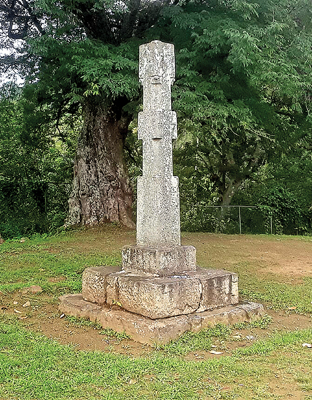
Bomure memorial of King Sri Wickrema Rajasingha in Dumbara (Pic: Internet)
The wall in the cell is adorned with a few paintings visualising key events and persons, in the episode of the King’s capture. Among them are portraits of King Sri Wickrama Rajasingha, his consort Venkata Rangammal Devi, over them are smaller paintings of the Kandyan Kingdom’s flag, Sri Dalada Maligawa and the Kandy Lake.
Flanked by them on the left side is a portrait of Pilimathalawe Maha Adikaram who elevated the King to the throne. Adjoining that is a painting of Muthu Mandapam, a memorial tombstone in Vellore, South India, where the King’s ashes were enshrined after his cremation (he died on January 30, 1832). On the right side of the wall is a portrait of Sir Robert Brownrigg, the British Governor who was in Ceylon when the King was captured by the British in 1815. Further right is a painting of the H.M.S. Cronwallis, a ship which had sailed to Vellore Port carrying the captive King and his entourage as prisoners. Viewing these clusters of paintings, one can imagine how feudalists betrayed the country to Western imperialism.
Last Kandyan monarch
The last Kandyan monarch was a very controversial figure. He was a distant relative of the Nayakkar King of South India, and at the age of 18, he was named King by the Prime Minister, Pilimatalawa (the Adikaram), who was intent upon appointing a temporary, puppet king. But the Prime Minister’s plan did not work out as intended, as Sri Wickrama Rajasingha grew to become a crafty politician in his own right.
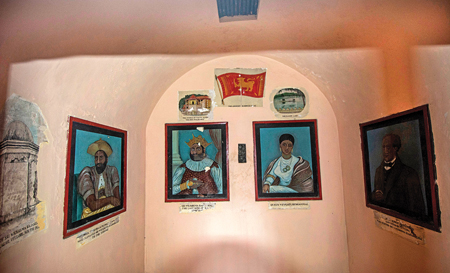
The inside wall of the cell is decorated with paintings and portraits of the King, queen and other key figures
Known as Prince Kannasamy, Sri Wickrama Rajasingha, a King of the Nayakkar dynasty, was sworn-in, in 1798. He ruled Kandy till 1815, after which he was exiled by the British. Sri Wickrama Rajasingha made some important contributions to the Kandyan Kingdom. Architecture and the arts bloomed during his reign, from 1798 to 1815. The beautiful Kandy Lake, called Kiri Muhuda, was created during his rule, and many buildings, including additions to the Sri Dalada Maligawa, are now recognised as his work.
Sri Wickrama Rajasingha was a tyrant and a cruel ruler who sentenced many of his subjects to painful torture and death. Women, for example, were executed by being thrown. He condemned both the innocent and the guilty, and is, perhaps, most notorious for the brutal manner in which the wife, children and relatives of Ehelepola, his Prime Minister, were killed and drowned in the Bogambara Lake at his behest. The entire nation was shocked by the tragedy, and it was Ehelepola who eventually betrayed the King to the British.
As prisoners
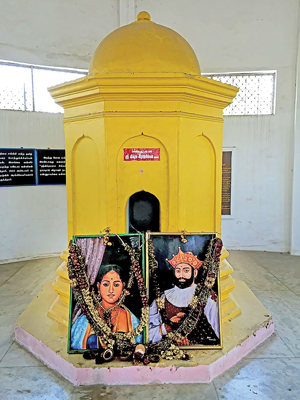
Muthu Mandapam, a memorial near King Sri Wickrama Rajasingha’s tombstone in Vellore, South India (Pic: Internet)
In January 1815, the British declared war on the King of Kandy, who then fled to the house of Gallehewatte Udupitiye Arachchilage at Bomura in Dumbara with his consorts and attendants. But his hiding place was soon discovered, and the King and his party were captured and sent to Colombo as prisoners of the British.
It is said that he was then imprisoned in this small cell, which is now seen in Colombo. In 1816, he was exiled to Vellore in India. Sri Wickrama Rajasingha was, then, formally dethroned, and the King of Great Britain was acknowledged as Sovereign of the island.
The ex-King, his queen and the others were taken to the ship H.M.S. Cronwallis under the supervision of Capt. O’Brien and deported to Vellore in Madras (now Chennai) on January 24, 1816 where he lived as a prisoner of war. King Sri Wickrama Rajasingha died on January 30, 1832, aged 52. Outside the Vellore Fort on the bank of the Palar River, one can see the tomb and memorial to Sri Lanka’s last monarch called the Muthu Mandapam (Pearl Hall), an Indian Government-designated tourist site. The last King of Ceylon who spent his final days in the country in this cell, is only alive in our memory.
Acknowledgement of the King of Great Britain as sovereign of the island marked the downfall of the last kingdom of Sri Lanka: The long line of Kings, dating back to the sixth century BC, had met its end in a one-room cell.





